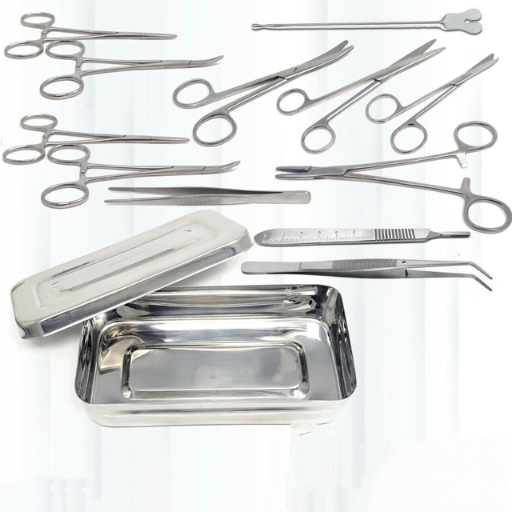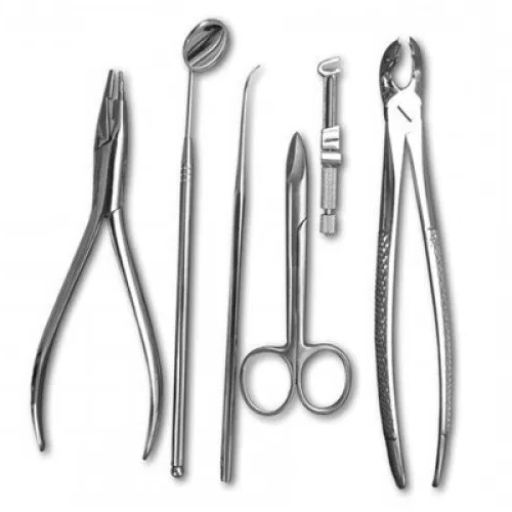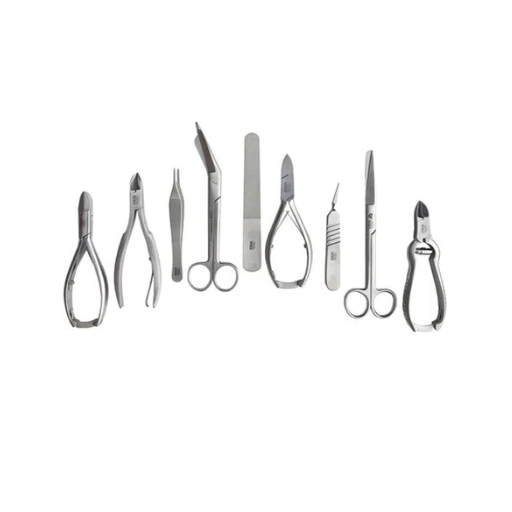Because surgical steel is used medically and surgically, it is recognized as a type of metal alloy that is manufactured from iron, nickel, and chromium. It is known to corrode easily. Still, how does surgical steel differ from other kinds of steel? Knowing its conductivity is crucial for people dealing with electricity. Get all the answers by reading the article. In the coming sections, we are going to do a surgical steel and conductivity analysis.
What is Surgical Steel and Its Mechanical Properties?

Surgi steel refers to a certain kind of stainless alloy. It gets its name from the combination of the words surgical and steel. The components of stainless steel are chromium, iron, and nickel. Chromium, to that matter, is quite important as it prevents the steel from corroding. It is also a nonreactive alloy, which is appropriate for contact in medicine and is compatible with the human body.
These benefits explain why surgical steel is used in both medical devices and industrial equipment.
Understanding the Physical Properties of Surgical Steel
| Property | Details |
|---|---|
| Composition | Iron, Chromium, Nickel, Molybdenum, Carbon |
| Density | 7.7 to 8.0 g/cm³ |
| Melting Point | 1400 – 1450°C |
| Corrosion Resistance | High, forms a self-healing chromium oxide layer |
| Biocompatibility | Biocompatible with low risk of reactions |
| Tensile Strength | Approximately 515 MPa |
| Yield Strength | Around 205 MPa |
| Magnetic Properties | Varies, dependent on alloy composition |
| Thermal Conductivity | 10 – 30 W/m·K |
| Hardness | Rockwell B scale, 79 – 95 range |
Exploring the Mechanical Properties of Surgical and Stainless Steel
| Mechanical Property | Surgical Steel | Stainless Steel |
|---|---|---|
| Tensile Strength | Approx. 515 MPa | Varies, up to 1100 MPa |
| Yield Strength | Around 205 MPa | Ranges from 250-1000 MPa |
| Hardness | Rockwell B scale, 79-95 | Depends on grade; up to Rockwell C |
| Ductility | High, elongation approx. 40% | Varies, up to 70% elongation |
| Fatigue Resistance | Above average, withstands cyclic stress | Good for austenitic steel grades |
Is Surgical Steel Conduct Electricity?

As we know, it is a metal. Thus, it has some degree of conduction due to its metallic character. However, surgical steel’s electrical conductivity is extremely low in comparison to other metals, particularly gold, silver, and copper. For this reason, surgical steel is not useful for applications that require high electrical conduction. Its best uses come from its strength, corrosion resistance, and biocompatibility, not electrical properties.
How Conductive is Surgical Steel?
Just like in the previous case, surgical steel does not stand out concerning its electrical conductivity. It is less electrically resistive than other metals, like copper, silver, or aluminum. Moreover, the particular alloy of surgical steel also affects its electrical resistivity; for surgical steel, it typically lies within the range of 60–75 micro-ohm centimeters (µΩ·cm). Copper, one of the best conductors of electricity, has an electrical resistivity of approximately 1.68 µΩ·cm. That means surgical steel is far less efficient at conducting electricity, approximately 40 to 50 times less efficient than copper.
The reasons behind its low conductivity are due to its composition. Surgical steel which is a type of stainless steel (like 316L) is an alloy of iron, chromium, and nickel with some molybdenum. The addition of these elements make the alloy stronger, more resistant to corrosion, and more compatible with biological tissue, but they lower its conductivity.
With this conductivity, surgical steel cannot be used for any electrical or electronic parts. Its primary applications are in the medical field in surgical implants, instruments, and even body jewelry, where its non-corrosive and durable properties are favored over conductivity.
For practical purposes, other conductive materials like gold or titanium alloys are used in medical and industrial settings.
Comparing the Conductivity of Surgical and Stainless Steel
| Property | Surgical Steel | Stainless Steel |
|---|---|---|
| Thermal Conductivity | Around 14 W/m·K | Typically 15-25 W/m·K |
| Electrical Conductivity | 1.4-1.6 MS/m, low | 1.45-1.7 MS/m, low |
| Heat Transfer Efficiency | Moderate | Higher in ferritic grades |
| Impact of Alloying | Chromium reduces conductance | Chromium, nickel affect both |
| Best for Insulation | Suitable | More suitable with low grades |
| Corrosion Resistance | Strong and consistent | Varies by alloy grade |
Why Steel is a Poor Conductor of Electricity
In comparison to metals like copper, silver, or aluminum, steel is considered a poor conductor of electrical current. This difference is associated with its steel’s composition, structure, or usage, and below you will find five detailed explanations:
- High Resistivity
When compared to current carrying metals, steel is said to have higher resistivity. For example, a copper wire has a resistivity of approximately 1.68 microohm-centimeters, while stainless steel usually has a resistivity between 60 and 70 microohm-centimeters. Because of these differences, steel can resist the flow of electric current more than other metals.
- Impurities in Composition
Steel is an alloy primarily made up of iron, and a mixture of other elements such as carbon, chromium and manganese. Because of these elements, the structure of iron becomes nonhomogeneous which lowers its ability to conduct electricity due to a lesser amount of electrons becoming available.
- Limited Free Electrons
Electrons conduct electricity in metals due to their mobility in the structure. Steel’s alloy nature, together with the added components, lowers the density of free electrons, which makes electricity conduction much easier in metals such as copper, iron, and silver.
- Crystal Structure and Boundaries within Grains
Steel contains microstructure features like grain boundaries and defects that arise from manufacturing processes. These boundaries, in comparison to purer metals, further impede the flow of electrons and create additional resistive barriers to electrical conductivity.
- Conductivity is Secondary when Compared to Oxidation Resistance
As mentioned earlier, stainless steel is specifically developed for properties such as durability and corrosion resistance, often coming at the expense of conductivity. Critical constituents like chromium, which is essential for oxidation resistance, tend to create passive layers that are detrimental to electrical conductivity.
Analysis of these features shows why steel is not preferred in applications that require high electrical conductivity, and other metals are favored in such cases.
Exploring the Thermal Conductivity of Surgical Steel

Compared to aluminum or copper, surgical steel has a low thermal conductivity. This is due to its composition containing chromium and nickel, which enhances the strength and resistance to corrosion, but at a cost to the surgical steel’s ability to conduct heat, efficiency. While surgical steel works well for medical purposes where the transfer of heat is not substantial, it is not suitable for applications with a high level of thermal conductivity demand. The specific type of properties in surgical steel makes it useful in the medical field.
Factors Affecting the Thermal Conductivity of Surgical Steel
As far as I know, the composition and structure of surgical steel greatly affect its thermal conductivity. From my understanding, alloying elements such as chromium and nickel boost resistance against corrosion, but this makes surgical steel much weaker in transferring heat. Moreover, the microstructure that results from certain manufacturing processes can be dense and more complex. This could further impede the flow of heat. All of these reasons combined explain why surgical steel is not suitable for applications that require high levels of thermal conductivity.
How Does Thermal Conductivity Impact Medical Applications?
Medical applications are impacted due to thermal conductivity affecting the effectiveness of surgical instruments and implants, for example, using surgical steel with lower conductivity serves to minimize the transfer of heat to the tissues, which could lead to damage during a procedure.
How Corrosion Resistance Affects Surgical Steel’s Conductivity

The corrosion resistance of surgical steel does not influence its thermal conductivity value in any way. Rather, the superior corrosion resistance guarantees that the material is reliable and useful in medical surroundings where exposure to blood or continuous sterilization is frequent. Although this property is very important to the integrity of the steel, it does not affect the thermal conductivity of the material.
The Role of Oxide Layer in Resistance to Corrosion
| Key Point | Description |
|---|---|
| Barrier Formation | The oxide layer acts as a protective barrier. |
| Prevents Oxygen Penetration | Blocks oxygen and moisture from reaching metal. |
| Improves Corrosion Resistance | Enhances durability in corrosive environments. |
| Material-Specific Effectiveness | Aluminum and chromium oxides are highly protective. |
| Porosity Matters | Dense oxides resist corrosion; porous ones (e.g., rust) do not. |
| Environmental Factors | Temperature, pH, and chemicals affect oxide layer stability. |
| Artificial Enhancement | Processes like anodizing strengthen oxide layers. |
| Self-Healing Properties | Some oxides can repair themselves, maintaining protection. |
| Thickness Impact | Thicker oxide layers often provide better protection. |
| Limitations | Not all oxides (e.g., iron oxide) are effective against corrosion. |
Understanding Corrosion Resistance in Surgical Instruments and Implants
Corrosion resistance properties of surgical instruments and medical implants are vital in ensuring these devices can function safely and effectively over prolonged usage periods. An intelligent choice of material, along with the nature of corrosion resistance properties of stainless steel and other alloys, is practical regarding the conditions posed by sterilization processes, body fluids, pH, and other factors due to bodily fluids. Here are some major contributors (corrosion resistance factors) to the corrosion resistance of medical materials, along with some relevant data points:
- Material Composition
Stainless steels are preferred due to the chromium content in the alloy, and thus, 316L is one of the popular grades because of its chromium inclusion and the resultant passive oxide layer, which enhances corrosion.
Some grades of stainless steel arise as an improvement in molybdenum by aids pitting and crevice corrosion resistance, which is more prevalent in chloride-rich waters.
- Formation of Protective Oxide Layer
An oxidizing agent advances corrosion and forms a layer that acts as a nebulizer, sealing and protecting the underlying material from further oxidation, which can deteriorate and damage the device.
This layer, which is powerful and non-polar, is known to be passively self-healing because if it is scratched or damaged, which represents the use of force against the oxide layer, it allows the rise of new material in the presence of oxygen.
- Electrochemical Stability in Body Fluids
The alloys of steel, tungsten, and titanium have strong resistance to electrolytic reactions occurring due to saline, blood, and other fluids found within the body.
Titanium’s remarkable reactivity with oxygen ensures the development of a steady layer of titanium dioxide, which improves corrosion resistance, even in harsh acidic or alkaline environments.
- Sterilization Compatibility
Materials utilized in the construction of surgical instruments and implants are required to withstand cycles of autoclave, exposure to chemical disinfectants, and high temperature, and retain their integrity.
Stainless steel possesses corrosion-resistant characteristics, even withstanding repeated cycles of sterilization.
- Surface Treatments and Coatings
Surface treatments like electropolishing enhance corrosion resistance by smoothing surface blemishes, yielding a lack of reactivity surface.
Other coatings, hydroxylapatite for bioimplants, can improve the bioactivity and durability of the coatings and materials used.
These facts illustrate the strategic choices of surface treatments and materials made concerning the construction of surgical instruments or implants for improved reliability and safety. There is still ongoing work from researchers and manufacturers focused on the development of these tools to optimize the metallurgy while ensuring the safety of the patients.
What Steel Grades are Used in Surgical Steel?

Because of their strength, resistance to corrosion, and compatibility with the human body, a few steel grades are widely used in surgical steel. The most widely used grades are:
- Grade 316L (Austenitic Stainless Steel): Due to its low carbon content relative to other alloys, 316L Austenitic Stainless Steel is widely utilized in the making of surgical implants and various surgical instruments. It is also resistant to corrosion, which makes it suitable for use in the body.
- 420 and 440A/B (Stainless Steel – Needle steels): These grades of Martensitic Stainless steel possess the locks of hardness needed for scalpels, scissors, and other surgical implements that require increased durability.
- O grade 304 (Austenitic Stainless Steel): Non-implantable instruments made from this grade can be used as it has good resistance to corrosion and can be easily sterilized.
These materials are chosen according to their characteristics and intended uses to provide maximum protection and safety in a medical setting.
Characteristics of 316L Stainless Steel and Its Conductivity
316L stainless steel has lower levels of carbon compared to 316 stainless steel. This makes 316L stand out due to its corrosion resistance and its ability to resist damage in harsh environments. This material is non-magnetic, exhibits superior strength, and is highly durable under tolerant conditions. Low levels of carbon also lower the risk of precipitation during welding, which enhances weldability.
Resistance To Corrosion
Marine, chemical processing and even medical implants are examples of functions using 316L steel due to the resistance it provides to pitting and crevice corrosion especially in chloride heavy settings. Also, 316L outperforms 304 grade when put in aggressive atmospheres providing promise in reliability and longevity in applications that are considered demanding.
Mechanical Properties
316L stainless exhibits impressive properties:
- Tensile Strength: ~ 485 MPa
- Yield Strength: ~ 170 MPa
- Elongation at Break: ~ 40%
These figures showcase the reliance on 316L when put under high stress without permanent deformity for structural integrity in critical applications.
Conductivity
Like most stainless steels, 316L stainless steel has relatively lower thermal and electrical conductivity when compared to copper or aluminum:
- Thermal Conductivity: Approximately 16.2 W/m·K (at 100°C)
- Electrical Resistivity: 7.4 x 10^-7 Ω·m
These numbers suggest that 316L’s conductivity is lower than that of other metals usually employed in electrical work, such as solder or copper; however, it is adequate for situations where durability and resistance to corrosion are more important than conductivity.
Medical and Industrial Applications
Because of its biocompatibility, 316L stainless steel is extensively used for surgical implants, prosthetics, and medical instruments. His strength and resistance to corrosion also make him an indispensable work material for marine equipment, pharmaceutical machinery, and food processing industries.
Particularly in the medical and industrial fields, 316L stainless steel is in high demand due to its superior anti-corrosive properties related to seawater, its robust mechanical strength, and suitable conductivity.
Comparing 304 Stainless Steel and 316 Stainless Steel
| Key Point | 304 Stainless Steel | 316 Stainless Steel |
|---|---|---|
| Corrosion Resistance | Good for most environments | Superior, especially in saline/chloride areas |
| Chemical Composition | No molybdenum | Contains 2% molybdenum |
| Cost | More affordable | More expensive |
| Applications | Food, medical, and architectural uses | Marine, chemical, and medical equipment |
| Heat Resistance | Handles high heat well | Better for extreme temperatures |
| Strength | High strength via cold working | Similar strength, better in harsh conditions |
| Magnetic Properties | Non-magnetic | Non-magnetic |
| Durability | Durable for general use | More durable in corrosive environments |
| Appearance | Similar to 316 | Similar to 304 |
| Welding/Forming | Excellent properties | Excellent properties |
Why Choose Surgical Stainless Steel for Medical Applications?
| Key Point | Description |
|---|---|
| Corrosion Resistance | High resistance due to the chromium oxide layer. |
| Hygiene | Non-porous, easy to clean, prevents bacterial growth. |
| Durability | Long-lasting, withstands wear and tear. |
| Sterilization | Tolerates high heat and harsh cleaning chemicals. |
| Biocompatibility | Safe for contact with body tissues and implants. |
| Non-Magnetic | Suitable for MRI environments and sensitive equipment. |
| Strength | High tensile strength, resists deformation. |
| Sustainability | Recyclable, eco-friendly material. |
| Applications | Used in surgical tools, implants, hospital furniture, and more. |
References
- Physics Stack Exchange: Discusses why stainless steel is a poor conductor of electricity compared to other metals, explaining the role of alloying elements like chromium in reducing electron mobility. Source
- Quora: Provides insights into the electrical conductivity of stainless steel, comparing it to other metals and explaining its relatively low conductivity. Source
- Reddit (AskScience): Discusses the conductivity of surgical plates and rods, highlighting the moderate conductivity of stainless steel compared to other metals. Source
Frequently Asked Questions (FAQ)
Q: Is surgical steel conductive?
A: Yes, surgical steel is conductive, but it is not considered a good electrical conductor compared to other metals used primarily for conducting electricity, such as copper or aluminum.
Q: What type of stainless steel is used in surgical instruments?
A: Surgical steel typically contains a specific alloy known for its high strength, corrosion resistance, and biocompatibility, making it suitable for medical use in implants and surgical tools.
Q: Why is surgical steel preferred for medical implants and surgical tools?
A: Surgical steel is used because it offers unique properties such as corrosion resistance, high strength, and biocompatibility, which are essential for ensuring that surgical implants and tools function safely and effectively within the body.
Q: Does surgical steel have a good ability to conduct heat?
A: Surgical steel has a moderate ability to conduct heat compared to other metals, but its specific heat capacity allows it to perform well in medical environments where thermal stability is crucial.
Q: What are the unique properties of surgical steel that benefit surgical procedures?
A: The unique properties of surgical steel include corrosion resistance, hardness and wear resistance, and biocompatibility, all of which are vital for the safe and effective use of surgical tools and dental instruments.
Q: How does the melting point of surgical steel affect its medical use?
A: The melting point of surgical steel is high, which contributes to its durability and ability to withstand the sterilization processes required for various medical devices used in surgical procedures.
Q: What considerations are important when choosing the right stainless steel for medical applications?
A: When choosing the right stainless steel for medical applications, considerations include its corrosion resistance, biocompatibility, hardness and wear resistance, and overall ability to conduct heat and electricity safely.
Q: Can surgical steel be used for electrical applications in medical devices?
A: While surgical steel is conductive, it is not typically used for electrical applications in medical devices due to its moderate electrical conductivity and the availability of metals with better electrical properties.
Q: What role does the alloy composition play in the properties of surgical steel?
A: The alloy composition of surgical steel determines its unique properties, including its strength, corrosion resistance, and biocompatibility, making it suitable for medical use in implants and surgical procedures.







